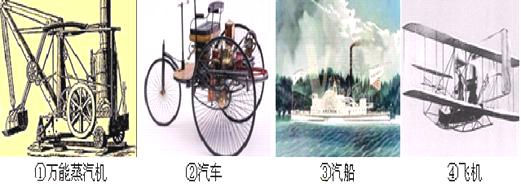2007年新年伊始,美国最大的时政类杂志之一—《时代》周刊最新一期(2007年1月22日出版)的封面上,“中国:一个新王朝的开始”几个大字赫然在列,红色的长城背后,一颗金黄色的五角星正冉冉升起(如右图)。杂志内文更是以11个页码的篇幅,详细报道了正在崛起的中国对世界的影响。这昭示着——中国的崛起令世界瞩目。阅读材料,回答问题。
材料一 孝公用商鞅之法,移风易俗,民以殷盛,国以富强。……夫物不产于秦,可宝者多;士不产于秦,而愿忠者众。
一一李斯《谋逐客书》
材料二 范睢曰:“王不如远交而近攻,得寸,则王之寸;得尺,亦王之尺也。”其后四十余年,秦国继续坚持范睢“远交近攻”之策,远交齐楚,首先攻下韩、魏,再从两翼进兵攻破赵、燕,统一北方,然后打败楚国平定南方,最后攻占齐国。
——“史记吧”网上资料
(1)根据材料一和材料二,分析秦国崛起的原因。
材料三 日本的“拿来主义”确实很值得后发展国家借鉴……明治维新后,手忙脚乱的新 * * 派出使团赴欧洲考察各国制度,以便为日本规划蓝图。代表团在考察后得出结论:一切仿效德国。
——钱乘旦《明治维新失误引出的历史教训》
(2)根据材料三并结合所学知识,概括19世纪末到二战前德、日崛起的共同特点及其对世界的主要影响。 (6分)
材料四 中国领导人曾明确指出:中国的崛起“不会妨碍任何人,也不会威胁任何人,也不会牺牲任何人”。和平崛起的中国,是世界和平与稳定的维护力量,而不是破坏力量;她为国际社会带来的只能是机遇,而不是威胁。
——摘自2005年8月9日《半月谈》:《中国和平崛起有益世界》(郑必坚文)
材料五 “中国的发展和崛起是和平的崛起,我们要走一条和一些大国不一样的道路,这条道路就是和平崛起的道路”……“因为我们有自己的文化,源远流长的文化,这种文化的核心又是‘以和为贵’,就是‘和’的文化。当然我们还要和而不同,这种不同是互相补充,是相互借鉴,而不是冲突的来源。”
——摘自2003年12月温 * * 在美国哈佛大学《把目光投向中国》的演讲
(3)从中国古代史和现代史中各举一例重要史实来证明材料四观点的正确性。
(4)综合上述材料和所学知识,分析温 * * * * 提出中国走“和平崛起”道路的历史和现实依据。
(1) ①商鞅变法使秦国在诸侯国中实力最强;②大量重用外来人才;③正确的外交战略。
(2)共同特点:①走发展资本主义道路;②利用最先进的科技革命成果后来居上,迅速赶超老牌资本主义国家;③积极向外扩张。
影响:①德国的崛起改变了资本主义世界力量的对比,引发了两次世界大战;②19世纪末,日本的崛起使其成为亚洲的军事强国,吞并了朝鲜、发动了侵略中国的甲午战争;20世纪中期日本成为二战的罪魁之一,破坏了周边国家的主权和领土完整,阻碍了周边国家的经济发展,使周边国家的人民蒙受了深重灾难。
(3)明朝郑和下西洋,发展了对外友好交往;1971年中国重返联合国,推动了世界和平与发展。
(4)历史和现实依据:①中 * * 具有爱好和平的历史传统;②中国近代备受列强侵略的屈辱;③古今中外正反两个方面的历史经验教训;④新中国坚持独立自主的和平外交政策;⑤中国的发展需要和平的国际环境;⑥中国政府的战略选择;⑦世界和平与发展的大势所趋。
(1)本题以大国崛起为主题来考察古今中外的相关历史,显性考察中国和平崛起这一社会热点问题。就这一小问而言,把握了材料一的“用商鞅之法”、“士不产于秦,而忠者众”和材料二的“远交近攻”几个关键词,答案即可迎刃而解
根据所学提炼两国崛起的共同点应该遵循如下思路:都是通过改良道路走上资本主义道路→带有浓厚的封建性和军事性→对外扩张;两者都是资本主义国家的后起之秀,易于吸收科技革命新成果。 第二问谈影响从扩展性这一主要特点入手,结合史实说明即可,答案要做到全面完整的关键在于紧扣“19世纪末到二战前”这一时间段
解题关键在于把握材料核心观点:中国的崛起是和平的维护者、是世界发展的机遇。答案是开放的,除了参考答案,另如古代的日本在大唐王朝的崛起中受益,当然还有其他邻国,当代中国积极参与国际事务的种种表现,如朝核六方会谈等等。注意:史实胜于雄辩
(4)解题关键在于审清题意:“结合材料和所学”,同时注意视野一定要开阔,不管历史还是现实依据,我们可以从国内国外两个方面来阐述。材料主要阐述了历史角度“和为贵”的文化传统,我们还应想到近代的屈辱史,想到他国武力崛起的历史教训;从现实角度看,除了参考答案,我们甚至可以从我们的社会性质、从我国所处的特殊国际环境、从热核时代的科技现状等角度阐述中国和平崛起的现实依据

